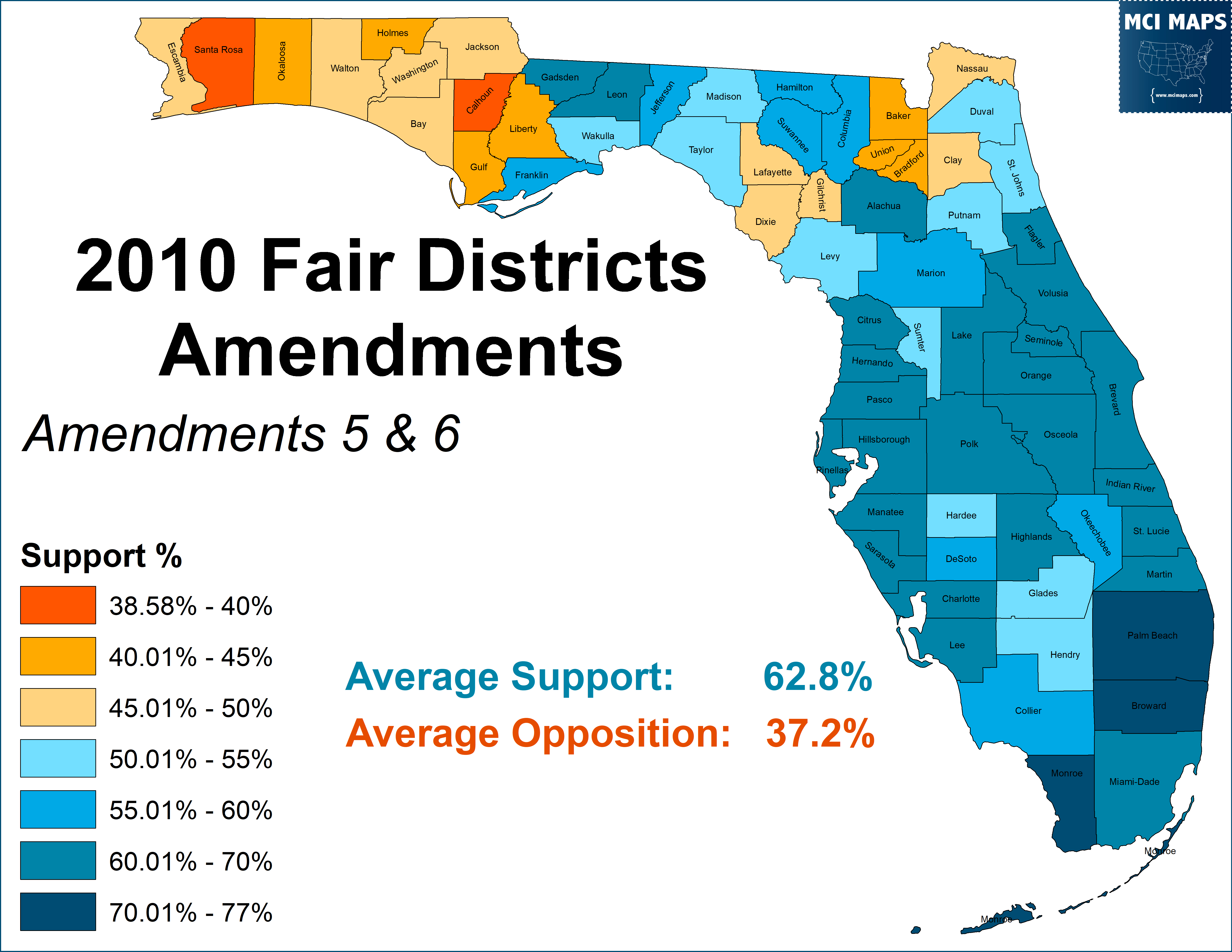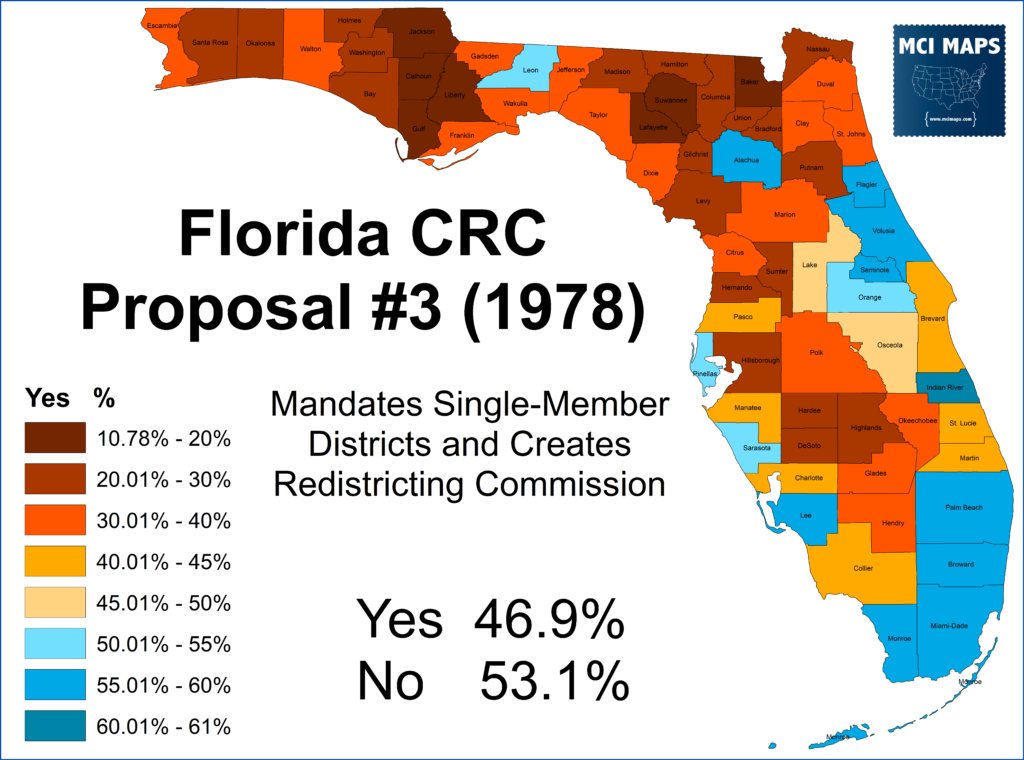Last week, I looked at the Republican gerrymanders of Florida in 2002. That round of redistricting marked the first time the GOP had control of the process. Democratic gerrymanders preceded in 1972 and 1982 – while the 1990s process was a more complex affair. Democrats had long resisted efforts to reform the process. However, finding themselves out of power, Democratic orgs would team up with good government groups to try and push reforms. This article will focus on that effort – which led to the Fair Districts Campaign of 2010.
Path to the Ballot
Past Reform Efforts
As I have hinted at in past articles, efforts to reform redistricting in Florida have been in the works for decades. In 1978, Florida voters rejected a measure that would create a redistricting commission and barred multi-member districts. You can read my article on the 1970s to get a better feel for the politics of the time.
While broadly popular in pre-election polls, the measure lost amid a massive rejection of all ballot measures that year.
After the 1978 loss, good government groups teamed up with Republicans and with the NAACP (both who had gripes about the Democratic mapping process) to try again for a 1980 ballot measure. However, the signature gathering efforts fell short.
After the 1992 redistricting drama, the legislature batted around a possible redistricting commission. However, back and forth debates between both chambers eventually ended with no plan going forward.
In 1998, as Florida’s Constitutional Revision Commission met, an effort to get a redistricting commission on the ballot almost succeeded. A plan to create a 7-member commission failed by one vote; heavily driven by Republican opposition. A similar effort in the legislature that same year failed thanks to GOP opposition. By this point in time, Republicans controlled the legislature and were on the cusp of electing Jeb Bush as Governor. Republicans, correctly, believed they’d likely control 2002’s redistricting process. Democrats, who’d long opposed reforms, but now out of power, championed change.
In 2005, a coalition of organizations formed The Committee for Fair Districts. The goal of this group was a 2006 ballot measure that would mandate a redistricting commission, as well as setting up rules for mapmakers to follow. After raising millions and collecting over 900,000 signatures, the proposal was set for the ballot. However, the Florida Supreme Court struck the measure off the ballot in a 6-1 ruling. The reason? The measure violated the state’s single-subject rule for petition-driven amendments. The commission and rules were considered two issues. This was a major setback, but the organizers of the effort vowed to continue on.
New Push
After the 2006 setback, the Fair Districts organization re-tooled their plan. Their leader, Betty Castor, a former Education Commissioner and 2004 Senate Candidate, brought in lawyers to ensure new language didn’t risk a court strike-down. They also met with minority communities to gauge support for these reforms. One major hang-up the realized was that minority voters did not trust a redistricting commission.
“They just didn’t trust it to protect the rights of minority voters.”
Fair Districts attorney Ellen Freidin, upon talking with African-American organizations
The skepticism among minority voters, especially African-Americans, is not entirely surprising. Minority communities had finally achieved what they viewed as their fair share of districts, and worried a commission would undo these gains. Proponents of the reforms needed to keep as many communities on board as possible. In 2006, Florida passed an amendment that required all ballot measures to secure 60% of the vote.
As a result of the opposition to a commission, the organization focused on guidelines for redistricting. The organization created draft language setting up redistricting rules: with the biggest item being barring political gerrymandering.
The measures set up two tiers for redistricting regulation in Florida.
- Tier 1 – Lines cannot be drawn to favor or disfavor an incumbent or party. Districts also cannot be drawn to diminish the ability of racial or language minorities to elect candidates of their choosing. Districts must be made up of contiguous territory.
- Tier 2 – Districts must be compact, as equal in population as possible, and honor administrative boundaries when possible.
Tier 1 takes priority, but both tiers are to be considered whenever possible.
TWO amendments were created, one for Congress and one for State Legislature.
Legislative districts or districting plans may not be drawn to favor or disfavor an incumbent or political party. Districts shall not be drawn to deny racial or language minorities the equal opportunity to participate in the political process and elect representatives of their choice. Districts must be contiguous. Unless otherwise required, districts must be compact, as equal in population as feasible, and where feasible must make use of existing city, county and geographical boundaries.
Ballot Summary Legislative Redistricting Amendment
Congressional districts or districting plans may not be drawn to favor or disfavor an incumbent or political party. Districts shall not be drawn to deny racial or language minorities the equal opportunity to participate in the political process and elect representatives of their choice. Districts must be contiguous. Unless otherwise required, districts must be compact, as equal in population as feasible, and where feasible must make use of existing city, county and geographical boundaries.
Ballot Summary Congressional Redistricting Amendment
They then began organizing fundraising and campaign efforts. Both measures would need almost 700,000 signatures to get on the ballot. The committee was able to build up broad support. It has backing of good-government groups like Common Cause and the League of Women Voters, support from the NAACP, the League of Cities, and so on. While it did have some Republican backing, the vast majority of politicians backing the proposal were Democratic-aligned. Perhaps most important was the committee getting prominent African-Americans to support the effort. Former State Senator Daryl Jones, who was a major minority-district advocate in the 1990s, was part of this effort.
After spending over $3 million dollars, the proposals had the signatures needed to get on the November of 2010 ballot. They would be Amendments 5 and Amendments 6.
Amendment 7 – Poison Pill
Republican leaders were not on board with Amendments 5 and 6; and made their opposition known. In April of 2010, they tried to add Amendment 7 to the ballot – passing it via the legislature to be put on the ballot. The measure said.
In establishing congressional and legislative district boundaries or plans, the state shall apply federal requirements and balance and implement the standards in the State Constitution. The state shall take into consideration the ability of racial and language minorities to participate in the political process and elect candidates of their choice, and communities of common interest other than political parties may be respected and promoted, both without subordination to any other provision of Article III of the State Constitution. Districts and plans are valid if the balancing and implementation of standards is rationally related to the standards contained in the State Constitution and is consistent with federal law.
Ballot summary of Amendment 7
The measure was pushed by Republican leaders but also had backing of multiple African-American lawmakers. Most notable where State Senators Gary Siplin and Al Lawson. Siplin was always cozy with Republicans, but Lawson, experiencing cracking by Democratic leaders in the 1980s, had perhaps a more legitimate wariness about the fate of minority districts under Amendments 5 and 6. This proposal was designed to confuse voters and short-circuit the 5 and 6 efforts. Namely its text effectively made adhering to the VRA enough to pass muster, regardless of other effects (aka the 2002 process). However, the Florida NAACP, as well as multiple other African-American lawmakers, opposed the measure.
Fair Districts proponents would get a break when the Supreme Court of Florida permanently struck the measure from the ballot; siding with the argument that the ballot language was vague and the measure was designed to sow confusion. This followed a July ruling from Circuit judge James Shelfer, who, in striking down the measure, quipped
“I’m not the brightest light on the Christmas tree, but it took me three days…to get a handle on what this amendment does.”
Judge Shelfer
The Florida Supreme Court agreed, and with that the measure was off the ballot.
The Campaign
Support/Money
Florida’s long history of gerrymandering gave proponents of reform plenty of ammo to bring ballot measures before the voters. I Democratic-aligned groups were the major funders: with the Florida Education Association giving over $1,000,000 and the SEUI giving over $500,000. The measures were also backed by good-government groups like the League of Women Voters and Common Cause. The committee Fair Districts Florida ran ads to push the measure.
The measures also had the backing of all major newspapers in the state. While the self-serving motives of Democrats and liberals was obvious, it didn’t change the fact most voters saw the reforms as needed. Fair Districts proponents worked hard to frame the issue around “good government” and not a left vs right issue. Past GOP support for redistricting reform was also highlighted.
Opposition/Money
The measures were heavily opposed by the Republican majority and Conservative groups. The Republican Party of Florida funneled over $2.6 million toward defeating the measures, while organizations like the Chamber of Commerce and BIG SUGAR donated 6-figure checks as well. The political committee, “Protect Your Vote” – with the slogan “Nix 5 & 6” was formed.
The opposition focused on two issues. 1) They claimed the measurers were financed by out-of-state groups, and 2) That the measures would harm minority representation.
Minority Voter Groups
The African-American community was divided on the amendments. Worried about the cracking of districts, multiple African-American politicians were hesitant or outright opposed to the measures. The divide was so notable that while the NAACP supported the amendments, some previous leaders of the same organization did not. African-American lawmakers divided on the measures.
While African-American districts dominated the discussion around Fair Districts, there was also concern in the Hispanic community. Much of the opposition came from the Cuban, GOP-aligned communities. Congressman Mario Diaz-Balart, who made sure to draw the FL-25 for himself in 2002, promised to sue over the proposals. He was joined by Congresswoman Corrine Brown, who vehemently opposed the measures. Brown’s opposition put her on the opposite side as the other African-American members of the delegation; who were largely silent on the measures (as best I can find). Brown was the face African-American opposition, perhaps rightly believing her current Jacksonville to Orlando district, which now served as a Republican gerrymander to pack Orlando’s black community, could not survive the new rules.
The Fair Districts organizers knew minority support was critical to get the measures past 60%. Targeted ads to African-American and Hispanic voters was undertaken. Spanish-language media was run and robocalls to the African-American community from prominent black leaders went out in October.
An October poll had YES leading 45-29, but with a large batch of undecideds. The poll showed the measures had support with Democrats, Republicans, and Independents. The question would be how undecideds broke.
The Results
As Florida’s results came in, the night was bad for Democrats and the left overall. The narrow Gubernatorial election went to Republican Rick Scott over Democrat Alex Sink.

In addition, Marco Rubio easily took the three-way Senate election – fending off Independent Charlie Crist and Democrat Kendrick Meek.
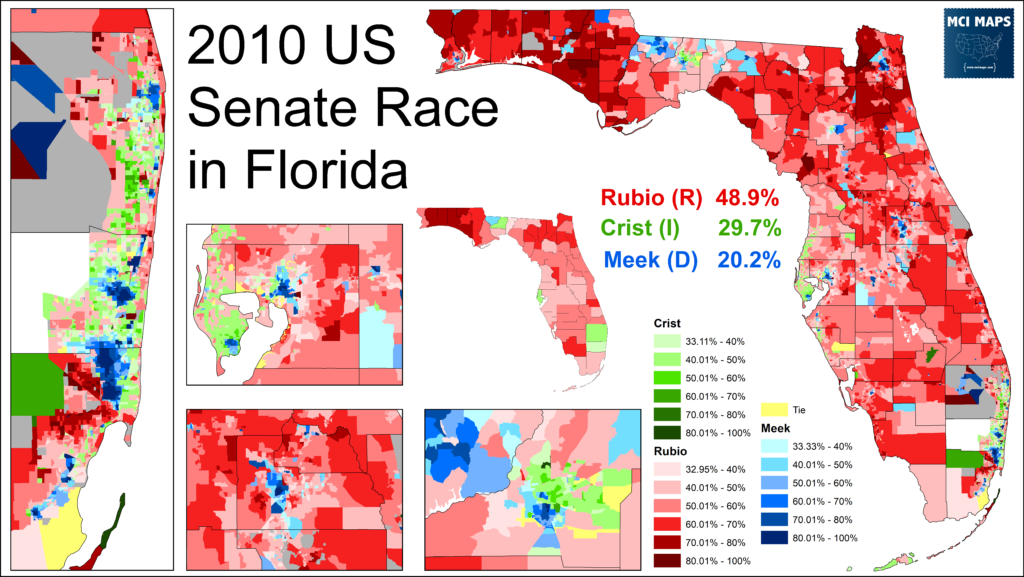
But there was good news for the Fair Districts supports – both measures cleared the 60% threshold. There was virtually no difference in support/opposition between the two measures – and both secured almost 63% support. There is no clear distinction between the two measures in terms of their bases of support. Small differences in vote totals are scattered across the precincts.
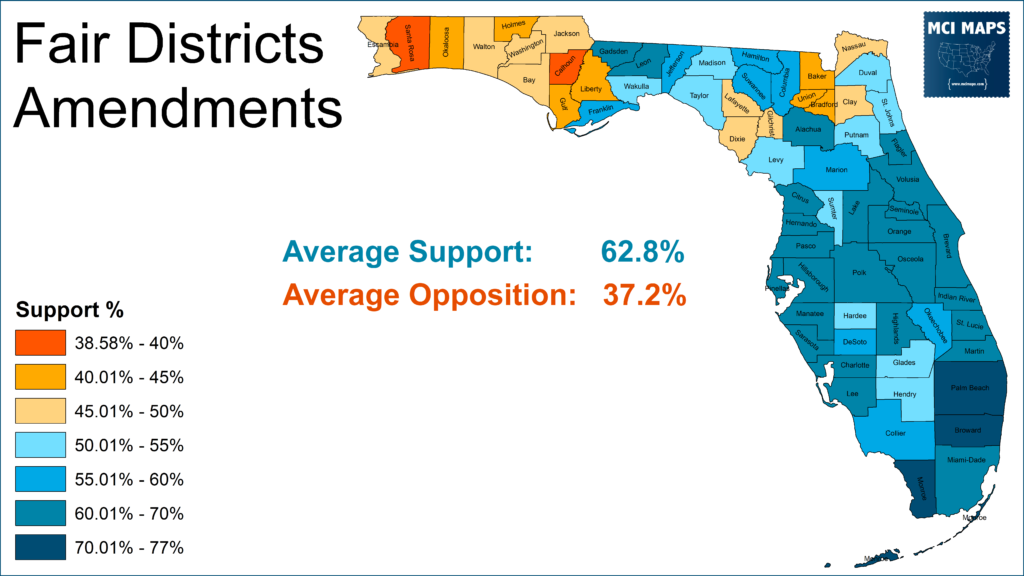
Since the votes for Amendments 5 and 6 nearly mirrored each-other, I’m just going to use Amendment 5 for analysis purposes.
Both Measures failed in the heavily-GOP panhandle and many rural counties. However, support crossed party lines in many instances; taking GOP suburbs and retiree communities.
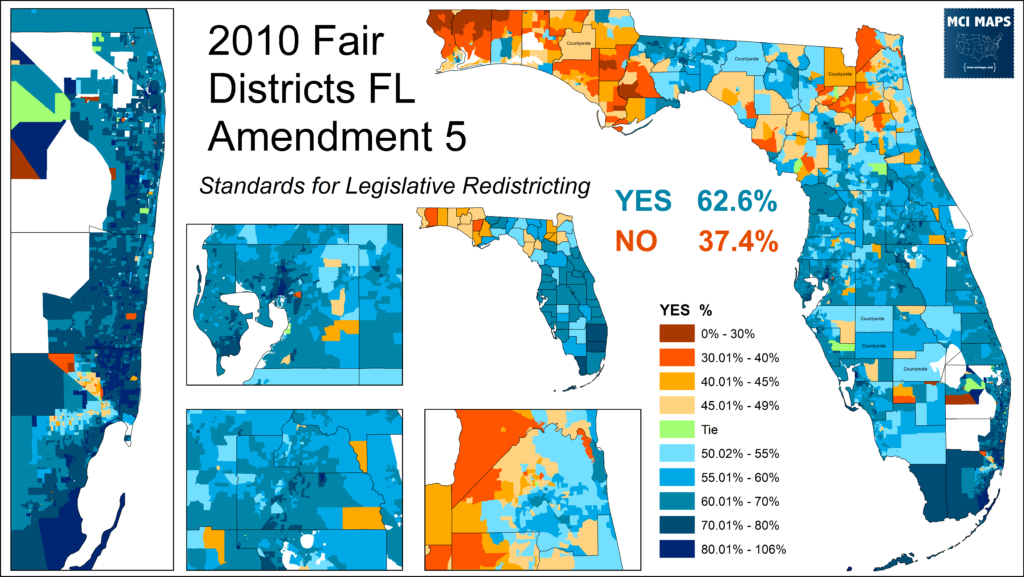
The precinct map shows a broad base of support. Outside of the conservative panhandle (which also had less crazy lines) – the measures easily passed; largely losing in just rural precincts. There is a notable opposition in Miami-Dade’s Cuban community. However, opposition does not appear to exist in other Hispanic blocks in or out of Miami-Dade. African-American precincts also broadly backed the measure; with most heavily-black precincts giving the measures well over 60%.
The most notable African-American opposition was in Duval County – which is Corrine Brown’s political base. Her vehement opposition to the measures resulted in the heavily African-American precincts in Jacksonville splitting on or narrowly opposing the amendments.
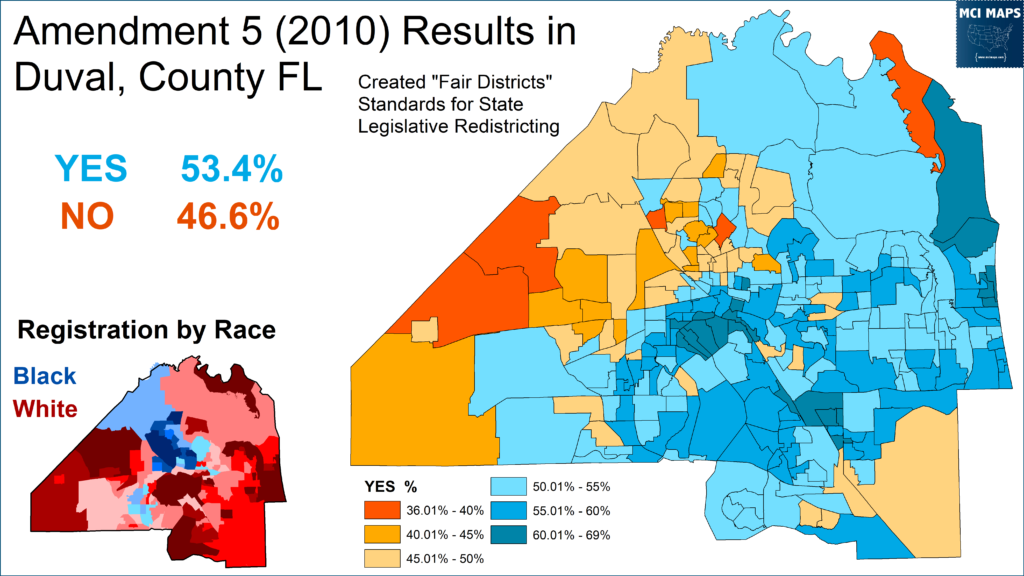
However, Brown’s influence did waned the further out of Jacksonville you got. African-American communities in Orlando and across the rest of Florida backed the measures.
Fair Districts was one of the only bright spots for Democrats in Florida that night. So how did it do compared to Alex Sink; the Democratic candidate for Governor?
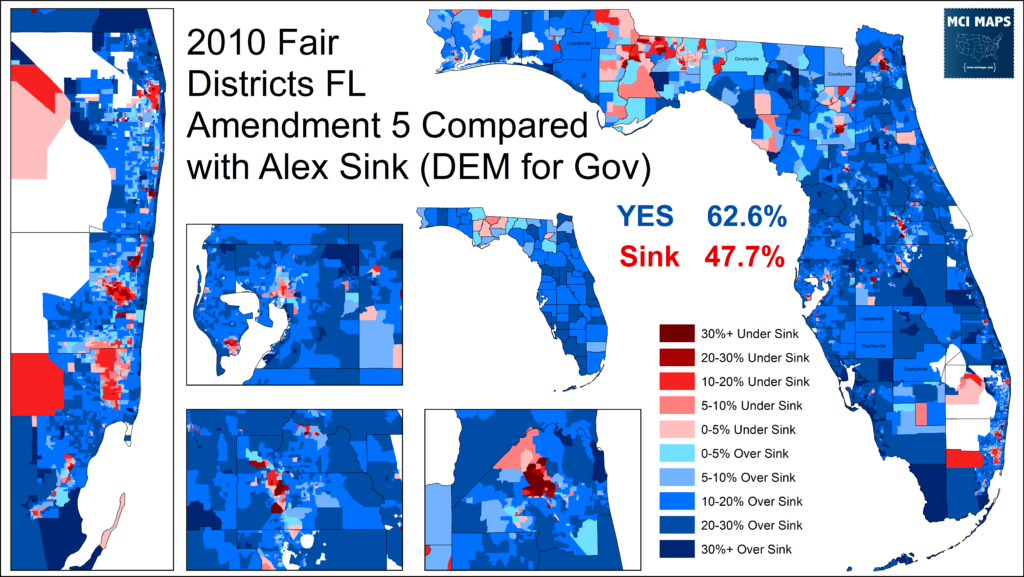
As the map shows, the Amendments outpaced Sink across the fast majority of Florida’s precincts. Some rural precincts actually gave Sink a larger vote (she did have North Carolina roots and played well in North Florida). However, the big data point is the African-American precincts giving much higher vote totals to Sink than to the Amendments. Sink averaged 85%-90% of the African-American precincts; while the Fair Districts amendments often came in around the 60s or low 70s. So while African-American support did exist for Fair Districts; it didn’t match the near-uniform support the community gives to Democrats.
Aftermath
In the aftermath of passage, the fight would not be over. Republican leaders in the state worked to stall or undermine the measures on multiple fronts in 2011, before finally agreeing to redistrict under the new guidelines. Next week, I will look at how Florida adjusted to the Fair Districts amendments and how the GOP majority worked to undermine the measures in every way possible.

